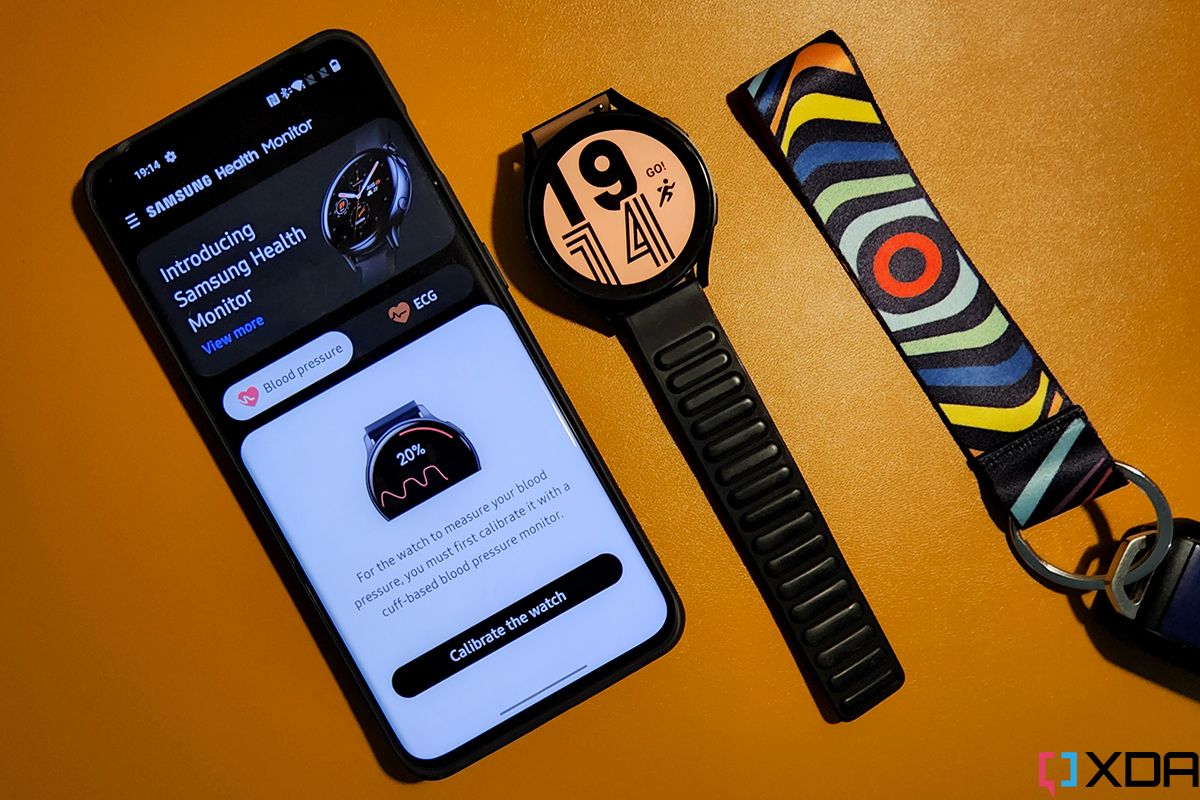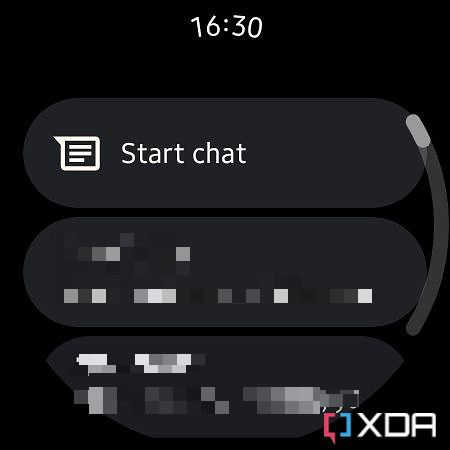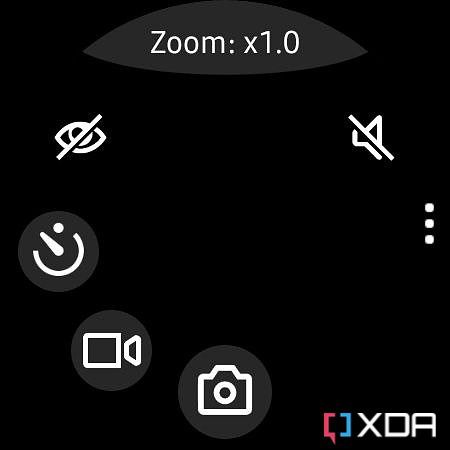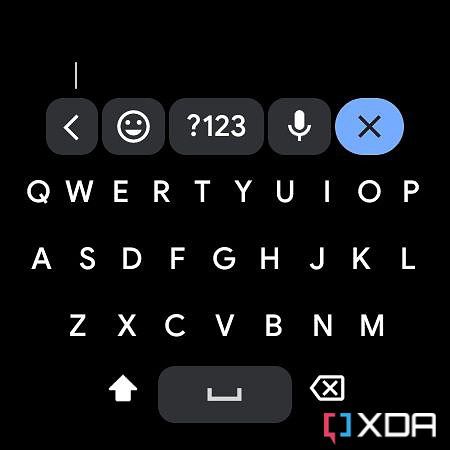The Asus ROG line of smartphones is a fairly under-popular one, and that’s thanks to the difficulty most will face in actually purchasing a device in the series. Depending on where you live, there may be no “normal” retailers to purchase one, so you may have to import it. Nevertheless, past smartphones in this series, like the ROG Phone 5, generally go all-out on specifications, and the Asus ROG Phone 6 Pro does exactly that. The Snapdragon 8 Plus Gen 1, dual front-firing speakers, two USB-C ports, and even a headphone jack — it has literally everything.

If what you want is a super-powerful phone with incredible specifications, and you don’t mind the camera not being the best of the best, then the Asus ROG Phone 6 Pro is definitely worth a shot. It’s pricey, but it’s also the most crazily-specced phone that I’ve used in a long time. It really does have everything.
- The Asus ROG Phone 6 Pro packs basically everything you could ever need in one package, and it looks great to boot. From the phone's presentation when unboxing to its overall aesthetic, Asus really knocked it out of the park.
|
Features: |
|
|
|
Pros: Cons: |

Asus ROG Phone 6 Pro: Specifications
| Specification | Asus ROG Phone 6 Pro |
|---|---|
| Build |
|
| Dimensions & Weight |
|
| Display |
|
| SoC |
|
| RAM & Storage |
|
| Battery & Charging |
|
| Security | In-display fingerprint sensor |
| Rear Camera(s) |
|
| Front Camera(s) | 12MP IMX663 |
| Port(s) |
|
| Audio |
|
| Connectivity |
|
| Software |
|
| Accessories/other features |
|
About this review: I received the Asus ROG Phone 6 Pro from Asus on the 17th of June, 2022. My colleague, Aamir Siddiqui, also received the device from Asus. While the company provided us with review units, it did not have any input into the contents of this review.
Asus ROG Phone 6 Pro: Design
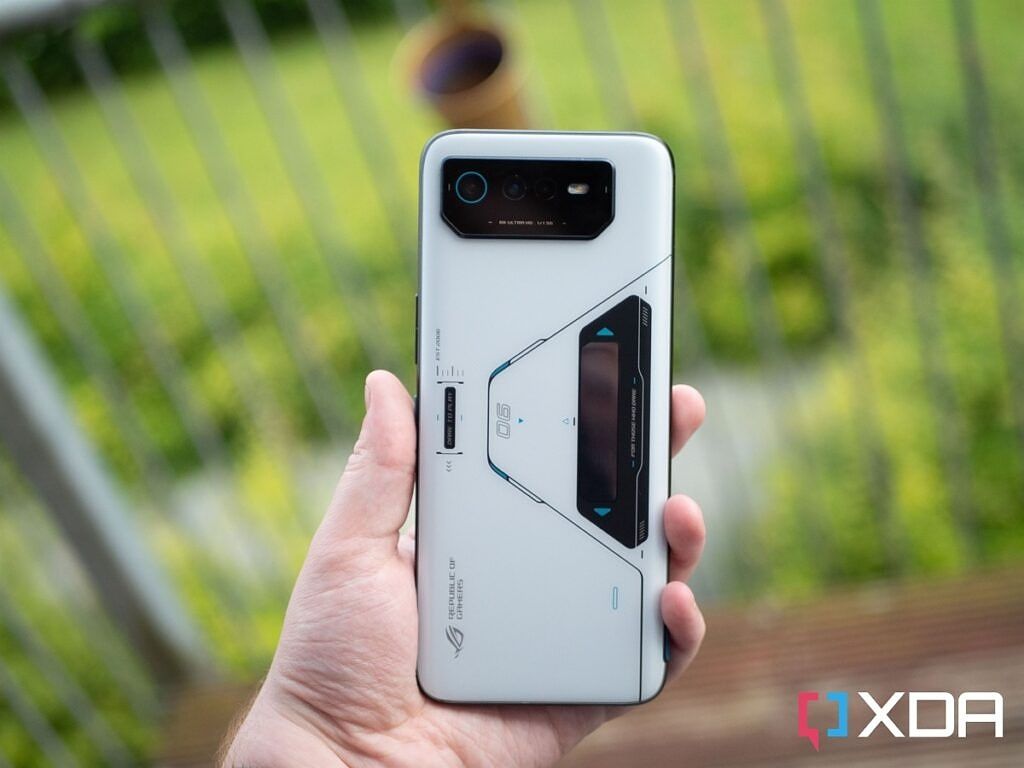
I like how Asus isn't afraid to do something different with the ROG Phone series
The best part of the Asus ROG Phone 6 Pro is that it’s not a gaming phone with the most gamer aesthetic. I’ve seen worse, and I like how Asus isn’t afraid to do something different. Asus added some accenting on the power button and the SIM tray. The aluminum frame also has ROG branding where the ultrasonic AirTriggers are. There are plenty of inscriptions on the back, but the camera module looks nice and the lit-up “dare to play” insignia looks cool.
Of course, the display on the back is also one of the most unique parts of the design of this phone. You can stick any animation you want on it, and there are plenty of pre-made animations that can be enabled in different scenarios, too. It’s fun, and that’s something I love to see on phones. Maybe it’s not your cup of tea, but you can disable it if you want to, or use it as a notification ticker.

Speaking of displays, though, the Asus ROG Phone 6 Pro does something special with it: there’s no notch, and there’s no punch-hole. That’s partially the reason for the screen being so big — the display is entirely unimpeded, with the front-facing camera being situated above the display instead. You get more than just that though too. You get dual front-facing speakers that are equally capable at each end, and you even get a notification LED — talk about a blast from the past. It’s not customizable, which is annoying (the most you can do is disable it on a per-app basis) but it’s incredible that it’s even present.
The display of the Asus ROG Phone 6 Pro is excellent, reaching up to 1200 nits of brightness on the 165Hz AMOLED panel. The reason for the lower resolution display is for performance pushing, as 1440p is graphically intensive to render. Particularly when trying to reacher higher frame rates like 165 FPS, every bit of overhead being freed up matters. While you can change the refresh rate to be as low as 60Hz (which also unlocks a DC Dimming option), it’s not an LTPO display.
What the Asus ROG Phone 6 Pro does have though is an even higher touch sampling rate, sitting comfortably above much of the competition at 720Hz. This means that it scans for input every 1.4ms, and Asus says that thanks to the increased touch sampling rate, the Asus ROG Phone 6 Pro has a touch latency of 23ms. The discrepancy is because while it can read input every 1.4ms, it still has to process that input.
That display isn’t just fast, though, it also supports HDR10+, and it’s powered by a Pixelworks i6 processor. The Pixelworks i6 processor can be used for tone mapping in HDR and is also used for refresh rate calibration. It basically provides a way to use AI to improve the screen quality, though Asus hasn’t explained how it’s used in this case. There are screen-off gestures too so that you can draw letters on the screen with the screen off to trigger actions.


There’s a second USB-C port on the left-hand side of the phone, and it’s even better than the bottom-firing one. It supports HDMI output, and it’s where some accessories (such as the AeroActive cooler) get plugged in. The bottom-firing USB-C port is your standard port, and it’s across from a 3.5mm headphone jack.
Another cool trick that the Asus ROG Phone 6 Pro pulls off is the addition of “Air Triggers”. They are ultrasonic zones on the side of the phone that can be used to detect various inputs, and can be assigned to actions in games through touch mappings. You can also use them throughout the system, and they enable a squeezing motion that you can use normally, too. On my device, I have it configured that when I squeeze the phone in my hand, the Google Assistant is called. You can enable a long squeeze or a short sweep, and you can also have a long press gesture for when you long-press both triggers.
The haptics of the Asus ROG Phone 6 Pro feels excellent in the hand
In games, Asus’ Air Triggers can detect the following:
- Tap
- Dual partition buttons (tap each side of the button)
- Swipe across
- Slide across (slower)
- Tap and swipe
- Tap and slide
Finally, the haptics of the Asus ROG Phone 6 Pro feels excellent in the hand. Typing is a great experience, and you won’t miss phone calls or notifications when the phone is in your pocket if you’re relying on vibration. Asus did a great job here, as they’re punchy without feeling over the top, and they avoid feeling “mushy” as some other phones may feel.
Asus ROG Phone 6 Pro: Performance
The entire point of the Asus ROG Phone 6 Pro can be summed up in one word: gaming. Pretty much everything about this phone was designed with consideration as to how it would affect the gaming experience, and obviously, performance is paramount when it comes to gaming. This phone has the fastest UFS 3.1 storage (and a lot of it), 18GB of LPDDR5 RAM, and the most powerful chipset at the heart of it — the Qualcomm Snapdragon 8 Plus Gen 1. This is the fastest Android smartphone on paper, and in reality, it matches that experience.
The Snapdragon 8 Plus Gen 1 features an improved Qualcomm Kryo CPU, with a Cortex-X2 prime core clocked at 3.2Ghz, three Cortex A710 performance cores clocked at 2.8GHz, and four Cortex A510 efficiency cores clocked at 2.0GHz. Qualcomm claims that the upgraded CPU is 10 percent faster than the one on the Snapdragon 8 Gen 1 and offers 30 percent better CPU power efficiency. We made similar findings in our testing of the Snapdragon 8 Plus Gen 1 reference device that Asus previously shared with us.
The ROG Phone 6 Pro is every bit as fast as you can expect
This phone is every bit as fast as you can expect, and while we’ll expand on it more in the battery section, the efficiency is up to snuff, too. This really is a powerful phone and the fastest that I have ever used. Pretty much every single game you can think of will run flawlessly, and I’ve been playing a lot of Ratchet & Clank and The Simpsons: Hit & Run. I can maintain a solid 60 FPS in both titles, and emulation is some of the most intensive processing you can put any smartphone through. I recently flew from Dublin to Berlin, and this phone with the Kunai GamePad and the AeroActive cooler, complete with AetherSX2, was what kept me company.

CPU Throttling Test


CPU Throttling Test is a freely available app on the Google Play Store, and it repeats a simple multithreaded test in C for as short as 15 minutes. We increased the length of time to 30 minutes. The app charts the score over time so you can see when the phone starts throttling. The score is measured in GIPS — or billion operations per second. It’s essentially a test that can measure the sustained performance of a chipset. While the phone does heat up, it’s not unbearably hot and is perfectly usable even at the hottest that it achieved.
With the AeroActive Cooler attached, I noticed as well that the Asus ROG Phone 6 Pro did perform better than you would expect. It achieved a maximum of 377 GIPs, whereas, without the cooler, the maximum it achieved was 341 GIPS. That’s nearly a 10% increase in maximum performance, and the average was also similarly higher with the cooler attached. It’s not a necessity, but it’s clear you’ll definitely have some benefits when using the cooler on your phone.
Gaming — The Simpsons: Hit & Run, and Genshin Impact
Playing The Simpsons: Hit & Run was a pleasant experience, and the game runs near flawlessly. I played with a 2x internal resolution, and the game ran at more or less 60 FPS at all times. The phone heated up a lot, but keep in mind that the phone was charging while playing. I also discovered an issue within AetherSX2 that was very specific to one mission. Whenever Professor Frink’s hovercar drove by cloaked, the GPU usage would jump to 100% and the FPS would tank. This threw off some of our results, though they were still impressive nonetheless. We measured the game’s performance with GameBench, and the results were as good as you’d expect.


The section on Genshin Impact was written by my colleague and XDA Editor-in-Chief, Aamir Siddiqui.
We mention the Genshin Impact experience in the Gaming Experience section below as well. For the purposes of objective testing, we ran the game at absolute maximum settings at 60 FPS. We also took measurements using the Gamebench phone app instead of the desktop app, so the phone was not charging throughout the session. Further, this test was conducted without the AeroActive Cooler 6.


As we mention further down, Genshin Impact is an amazing experience, with practically no noticeable frame drops at all. Genshin Impact has a bunch of loading screens, and the frame rate invariably drops at those instances, which is why you see the fps stability tanking a bit towards the end as I dipped in and out of realms to do resin-based artifact farming within the game. There’s a very slight throttling noticeable past the 10-minute mark, but remember, this is a game that is pushing the phone and the SoC to some of its highest peaks for extended durations. The temperature measured around the phone was around 37° C towards the sides where your fingers rest, while the SoC was a toasty 45° C. But because of the positioning of the chip towards the middle, you don’t actually feel this heat. We also played the game for about 37 minutes and recorded a 17% drop in battery. So even at the end of a 30+ minute maxed-out gaming session without using a cooler, your experience with the phone remains largely unchanged.
We would like to give special thanks to the team at GameBench for the tool they provided us. Their tool makes it possible for any person, whether it be a regular user, journalist, or engineer, to test a mobile game’s performance on an Android device. Check out GameBench to learn more.
Geekbench, 3DMark Wild Life Extreme, and Androbench
Geekbench is a CPU-centric test that we all know and love. It uses several computational workloads including encryption, compression (text and images), rendering, physics simulations, computer vision, ray tracing, speech recognition, and convolutional neural network inference on images. The score breakdown gives specific metrics. 3DMark Wild Life tests the GPU, and AndroBench tests the storage speed of the phone.



The ROG Phone 6 Pro presents chart-topping performance across the board
X-Mode


Asus’ X-Mode is a feature that essentially aims to maximize performance, and you can enable it at any time on your phone. It reduces thermal throttling and activates other features that can affect or improve your gaming experience. For example, you can have it disable background syncing, automatically enable HyperFusion, and automatically activate Dual-Band Wi-Fi. What I found interesting was that it defaulted to enabling the 144Hz screen refresh rate, rather than 165Hz. As a result, until I disabled it, entering X-Mode would actually reduce my screen refresh rate. It’s a bit of an odd quirk, but not a big deal as you can just disable it or change it to automatically increase the refresh rate to 165Hz instead.
The introduction of “dual-band wi-fi” is interesting, as there are very few use cases where it will actually help the end-user. It can’t increase ping, as each packet will be sent via a single route. Sending over multiple routes isn’t possible as packets would need to be split up, so it’s likely that your phone would simply stick to 5GHz for the lower latency.
As for increasing bandwidth, 5GHz Wi-Fi offers significantly higher bandwidth over 2.4GHz. I have gigabit internet, and without dual-band wi-fi enabled, I get 370 Mbps over Wi-Fi. With it enabled, I get 220 Mbps. I sometimes get a much lower score when I enable the feature versus disabling it. It’s completely inconsistent, which I can only imagine might be related to the fact that it’s switching between the two connections. I managed to get 430 Mbps one time with dual-band enabled, but most of the time it was either significantly lower or sometimes on par with just using my 5GHz network.
In short, your mileage may vary depending on your network conditions. It hasn’t really changed anything for me, and I’d rather leave a feature like this off in case it messes with the stability of my connection when playing games or when I’m on a call.
Game Genie



Asus’ Game Genie is a dashboard that launches alongside your games and can be accessed as an overlay. It offers quick and easy access to features you may want to modify or look at, such as screen recording, Air Trigger mapping, real-time stats, and more. It’s a fully thought-out overlay with a lot to offer, and you can even enable a crosshair, record macros, and search the internet all from the comfort of your overlay.
Gaming experience
This section was written by my colleague and XDA Editor-in-Chief, Aamir Siddiqui.
The Asus ROG Phone 6 Pro has an amazing experience when you are gaming, and you expect nothing else from a gaming smartphone and moreso from one aiming to be the best one around. My colleague Aamir Siddiqui has spent a fair few hours dipped across games like Genshin Impact, Ingress Prime, Pokemon Go, and Clash of Clans, to see what the experience has been.
For more casual titles, like Clash of Clans, the ROG Phone 6 Pro breaks no sweat, at all. You could easily be one hour deep into raiding villages and strategizing for your next clan war, and the phone will barely get warm. You don’t even need the AeroActive Cooler for casual titles played in landscape, as the phone does just fine with heat dissipation on its own. The SoC being centered also means that you just never really feel the heat. I wasn’t particularly able to take advantage of the ultrasonic AirTrigger 6 buttons on this particular game, as there is a lot more contextual tapping in the game depending on where you are deploying troops — I mapped the Next button to the right trigger for a tap, but the button in-game is fairly easy to reach with the thumb so I disabled it.

The situation is slightly different for Ingress Prime and Pokemon Go, both of which are games that are played in portrait orientation and outdoors: the weather is extremely hot and humid these days, and the SoC positioning makes this a fairly uncomfortable phone for portrait games. While the phone still doesn’t break a sweat, the ambient heat around you will make it so that you start noticing the heat emanating from the SoC. There is no thermal throttling, but the heat dissipation on the phone (any phone for that matter) and the placement of the SoC do not make it the best phone for an outdoor, portrait game. While the AeroActive cooler seems like a good idea to help with the heat dissipation, it’s not the best idea to add on for a game that requires so much movement as it adds a lot of bulk. The side-mounted USB Type C port is also good for attaching a power bank, albeit you have to be conscious of the weight of the phone.


The battery on the ROG Phone 6 Pro is amazing



Titles like Genshin Impact are precisely where the ROG Phone 6 Pro shines, and it shines brighter than anything I have ever played this game on. Genshin Impact is played in landscape, and you can switch the graphics from the modest settings that are selected by the game by default, and crank it all the way up to the max. You can play this game at max at 60fps, and even after 2 hours of continuous gaming, there was no noticeable lag or throttling in the game, at least nothing that I could experience in the middle of all the action and cutscenes. Genshin Impact plays so amazingly on this phone, it is almost like the ROG Phone 6 Pro begs you to play the game on max, and the phone enjoys making short work of the game like its no-big-deal.
Yes, the phone gets hot when you do push it to these settings. But which phone doesn’t? What surprises me is the sheer consistency of performance: the game performs perceivably the same at the end of 120 minutes of gaming as it did on the first minute of gaming. Yes, the aluminum frame also becomes fairly hot to touch by the end of it, and that’s an indication for you to either take a break or make use of the case that came along with the phone to add another layer between yourself and the phone. Using the AeroActive 6 cooler on Genshin Impact was a good experience, although there is a separate conversation to be had on how the heat is exhausted right onto your fingers (more on this in our dedicated AeroActive 6 cooler review, coming soon).

Genshin Impact was the game on which I could finally make use of the AirTriggers with some sense. I had them mapped for jumping and sprinting for the tap action which fit in well with how I played the game. I had the buttons on the AeroActive 6 cooler mapped to dialogue points since I find them annoying to tap with the thumb every 3 seconds. I realize I still am underutilizing the ultrasonic buttons and the cooler buttons, so something I would have liked is a way for Asus to share recommended presets for some popular games. Or maybe a way for users to share their mappings for different games, as there is a whole bunch of permutations and combinations to explore here. Games like PUBG Mobile with a lot more static, non-contextual buttons on the screen will be able to take better advantage of AirTriggers.
What adds to the experience on Genshin Impact at max settings are the dual front-firing speakers. Genshin has some amazing music in its cutscenes, and the ROG Phone 6 Pro plays them back with richness and depth. You’ll very likely end up bringing the volume down soon enough since the game has repetitive music for combat. But the phone delivers, so you can rest assured that the great experience carries on over to other landscape titles like PUBG Mobile, Call of Duty Mobile, and Fortnite.
UI Stutter/Jank test







To quantify how well the Asus ROG Phone 6 Pro can maintain 165 FPS in real-world scenarios, we ran a modified version of Google’s open-source JankBench benchmark. This benchmark simulates a handful of common tasks you’ll see in everyday apps, including scrolling through a ListView with text, scrolling through a ListView with images, scrolling through a grid view with a shadow effect, scrolling through a low-hitrate text render view, scrolling through a high-hitrate text render view, inputting and editing text with the keyboard, repeating overdraws with cards, and uploading bitmaps. Our script records the draw time for each frame during the test, eventually plotting all the frames and their draw times in a plot along with several horizontal lines representing the target frame draw times for the 4 common display refresh rates (60Hz, 120Hz, 144Hz, and 165Hz.)
The results above show that Asus is somewhat conservative when it allows the Asus ROG Phone 6 Pro to reach that 165Hz goal. It definitely can do it, but it’s clear that the company is a bit heavy-handed in when apps can utilize it. I haven’t noticed it dropping, but it clearly does at times.
Asus ROG Phone 6 Pro: Camera

This is a gaming phone, and as is always the case with a gaming phone, the camera is the least important aspect. Unsurprisingly, though, in Asus’ pursuit of greatness, the camera got a little bit of love too. It’s not a worldbeater by any stretch, nor would I say that you should ever be buying this phone for the camera. But surprisingly, it’s actually decent. I was able to get some decent shots with it and even took it with me to a concert where I was surprised by the video quality.
Asus packs the Sony IMX766 50MP sensor as a primary shooter, a 13MP ultra-wide, and a 5MP macro camera. There’s no dedicated telephoto option here, but Asus uses the 50MP sensor to shoot at 2x lossless in bright light situations. When it’s dark, it turns to digital zoom. Asus put a pretty capable shooter in this smartphone, enough that I think pretty much anyone buying a gaming phone for gaming will be happy with it.
As for 8K video recording, it’s mostly just a gimmick. You’ll be hard pushed to find anything that can play 8K video and display it natively, and you lose out on all of the benefits at recording at a more “normal” resolution. There’s no EIS, there’s no additional HDR processing, and it’s essentially just a “raw” video. You can use it if you’d like, but I’d definitely recommend recording in something like 4K instead if you want high-resolution video footage.
Asus ROG Phone 6 Pro: Software
The software of the Asus ROG Phone 6 Pro greatly impressed me, a lot more than I expected it to. For context, I’ve never used an Asus smartphone before, and my only experience of gaming phones has been through the likes of Black Shark and RedMagic. As a result, I’m used to the over-the-top gamer UI that those companies frequently pack, and I was amazed to learn that that wasn’t the case here. In fact, ZenUI is an incredibly tame implementation of Android 12 with some genuinely useful features. You can opt for a gamer-y icon pack aesthetic at setup, but Asus lets you water that down to a more regular-looking icon set if you want to.






There haven’t been many issues I ran into when it came to software. The biggest that I found is that the audio will crackle when the screen rotation changes, though that’s about it. I get notifications, apps work, they aren’t really killed in the background, and it’s overall a pleasant experience. Asus did a great job here, and I haven’t found that there’s any “bloat” in terms of features. Everything that’s needed to use a modern Android smartphone is here, along with Armoury Crate for changing lighting effects and others.
There were a couple of features that stood out to me, though. Asus has surfaced a couple of options from developer options to be accessible through normal menus, including animation speed changing and codec choosing for Bluetooth earphones. Both of these are features that normal users may want to take a look at (especially animation speed) so it totally makes sense to surface these for normal users to take a look at.
As well, Asus introduces other features too, such as Optiflex. Optiflex “accelerates app launches, reduces app reloads, and saves power on standby” according to the company, and is enabled by default for Google Chrome, Facebook, Gmail, and YouTube on my device. It can auto-select based on usage. There’s also Twin App support so that you can have two versions of the same app at the same time: for example, two WhatsApp accounts.
I think it's fair to call the ROG Phone 6 Pro the Google Pixel of gaming phones
In a sense, I think it’s fair to call this the Google Pixel of gaming phones. While there aren’t a lot of software features, the ones that Asus incorporates are completely nailed. The company did a fantastic job at software, packing features that practically everyone will make use of. There’s a level of simplicity I can really appreciate, as there’s nothing that gets in between you and your gaming.
Asus ROG Phone 6 Pro: Battery & Charging
The Asus ROG Phone 6 Pro packs a pretty monstrous 6,000 mAh battery, one of the largest in any flagship phone currently. Couple that with the new Snapdragon 8 Plus Gen 1, and Asus is on to a winner. I’ve seen as high as eight hours of screen on time from my heavy usage, though it’ll typically be between four and six hours — still very good. That includes gaming, a lot of photography, a lot of messaging, media consumption, and more.

As for charging, the Asus ROG Phone 6 Pro packs a 65W USB PD-compliant charger in the box. You can use it to charge all of your other USB PD devices too, making it one of the best USB PD chargers out there. I use it to charge my laptop as well, so it’s the only charger that I need to bring with me when I got out. Basically, you’ll get it from 0% to 100% in under 45 minutes, which is incredibly fast and on-par with pretty much all other flagship phones on the market right now.








The Asus ROG Phone 6 Pro achieves some really good battery life, and it seems to be a combination of the more efficient Snapdragon 8 Plus Gen 1 chipset, and the massive battery that the phone contains, too. No matter what, it bodes well for future flagship phones that companies are going to release with this new chipset, and hopefully, all of them have much-improved battery life.
If you’re impressed by that battery life, you’ll also want to protect the battery as much as possible to prevent that capacity from being diminished. Thankfully, Asus has two protections built in that will help you do exactly that. The first is bypass charging, which you can enable and will allow you to power your phone without charging the battery and without using it up, either. It basically powers your phone directly from the wall outlet, so less heat is generated and your battery can “rest”.


On top of that, you enable both “steady charging” and a battery charging limit. Steady charging will charge your phone slower to, again, generate less heat, and the charging limit will allow you to limit charging your phone to 80%, 90%, or 100% if you want to protect your battery health, too.
Asus ROG Phone 6 Pro: Miscellaneous
Security
The Asus ROG Phone 6 Pro has face unlock and an under-display optical fingerprint scanner. Both options work well, though face unlocking won’t work with a mask on.
Audio
The speakers on the Asus ROG Phone 6 Pro sound phenomenal. They get really loud, are equally balanced, and are the best speakers I have ever heard on a smartphone. What’s more, you get a headphone jack if you want to listen to wired audio (particularly when you’re gaming), so it’s an all-around great experience when listening to music or playing games.
IP Rating
The ROG Phone 6 series comes with an IPX4 rating, meaning the smartphone can handle a few splashes of water, and you should avoid getting it wet beyond that point. This may not seem particularly impressive in this day and age of IP68 smartphones, but this phone has a dramatically different design and port situation than those smartphones. I would have loved to see a higher rating, obviously, but considering everything else this phone can do, an IPX4 rating works for now.
Bootloader unlocking, kernel sources, and software updates
You can unlock the bootloader of the Asus ROG Phone 6 Pro, and Asus has already released both the unlocking tool and the kernel source. The unlocking process completely wipes the phone and disables subsequent OTA updates. Furthermore, an unlocked bootloader may void the warranty for this device
Software updates are the biggest downside of this phone. Despite the incredible hardware specifications thrown at it, it’s a shame that Asus will only support it with up to two major Android platform updates. With many companies extending that support to three or even four years of updates, Asus has stagnated and only stuck with two.
Should you buy the Asus ROG Phone 6 Pro?
There's so much to love about the ROG Phone 6
I absolutely love the Asus ROG Phone 6 Pro, and I’m blown away by just how much the company put into this phone. Is it overkill? Certainly. Is it cool? Extremely. If what you want is a gaming phone that serves as a normal smartphone too, then this is honestly the phone to get. It really does do it all, and without the cringe hardcore gamer aesthetics too, it’s a phone that would fit pretty much anyone. The only issue is pricing; coming in at €1299 (that’s £1099 in the U.K.), it’s a pricey smartphone to come across. That with the shorter support window may concern you, and that’s to be expected. In fact, if you want to save a bit of money, the regular ROG Phone 6 might be up your alley. It costs €999, and all you’ll lose is the customizable back panel, and you’ll downgrade to just be able to get up to 16GB of RAM. Oh, the horror.
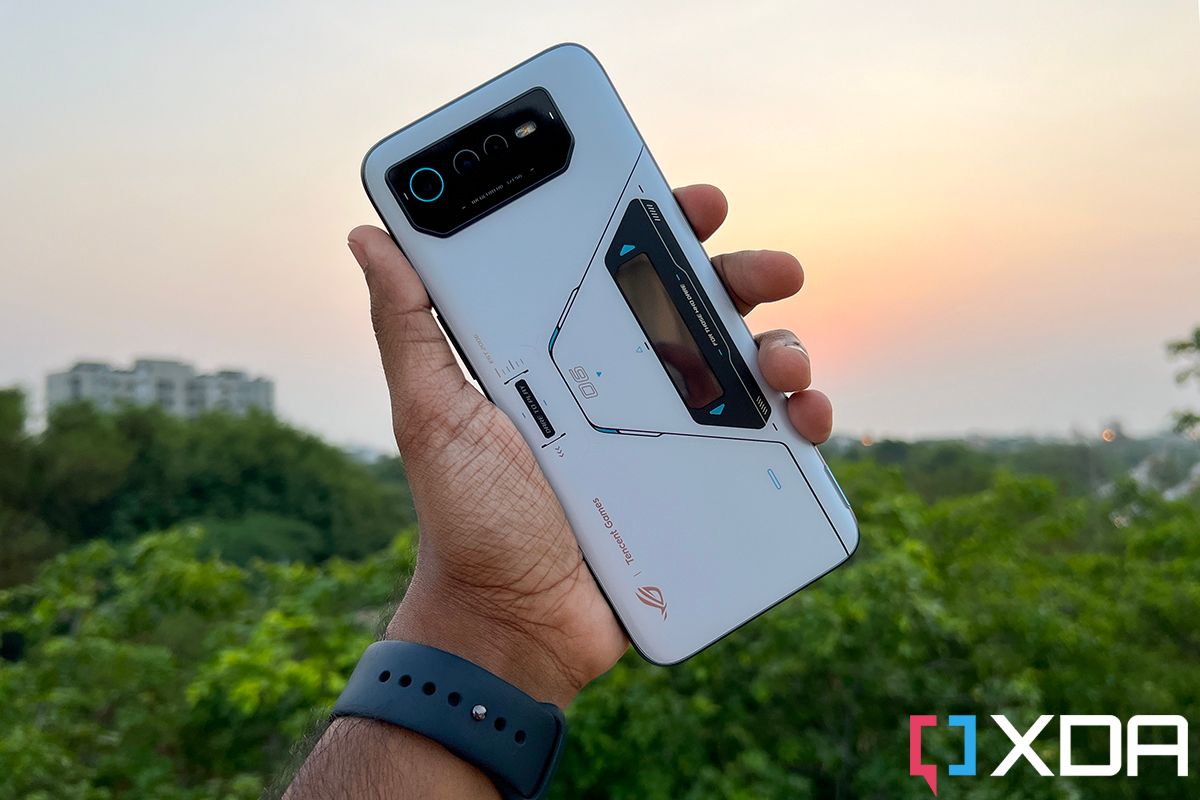
Nevertheless, I think that smartphones like these do serve a purpose, and it’s clear that Asus is targeting a little bit more of the mainstream now. The cameras are certainly a weak point, but even those can be forgiven when there’s this much power. Google does a terrible job at gaming but a great job at software and cameras. Asus does a great job at gaming and software but doesn’t really impress with the cameras. So in a way, it truly is the Google Pixel Ultra of gaming.
- The Asus ROG Phone 6 Pro packs basically everything you could ever need in one package, and it looks great to boot. From the phone's presentation when unboxing to its overall aesthetic, Asus really knocked it out of the park.
The post Asus ROG Phone 6 Pro Review: The Pixel Ultra of gaming phones appeared first on XDA.
from XDA https://ift.tt/3fmYVa8
via IFTTT





















